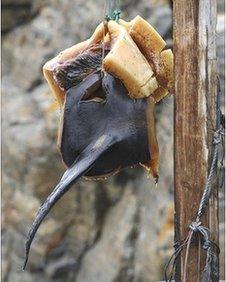Whaling talks focus on 'too commercial' Arctic claims
- Published

Alaskan Inupiat communities catch about 56 bowhead whales under ASW rules each year
The annual meeting of the International Whaling Commission (IWC) has opened with the focus on hunting by indigenous groups mainly in the Arctic.
The five-yearly quotas awarded to Inuit and other peoples are due for renewal, with Greenland asking for an increase.
Animal welfare groups charge that much of the meat is sold commercially, and that whales take too long to die.
Governments have reportedly agreed not to repeat last year's walkout, and votes are due on several issues.
These include proposals to declare the South Atlantic a whale sanctuary and to ask the UN to take charge of whale conservation.
But for a number of countries, including the US, renewing quotas for their indigenous peoples under Aboriginal Subsistence Whaling (ASW) rules is the top priority.
"We distinguish between commercial whaling, which we oppose, and ASW which we strongly support," said Doug DeMaster, acting US commissioner to the IWC.
"The cultural needs, the recognised tradition - we support the aboriginal use of large whales if they meet a 'needs' criteria that's established by the IWC, and if the removal levels are considered sustainable by the scientific committee of the IWC."
Time-to-death figures
Alaskan Inupiat communities catch about 56 bowhead whales under ASW rules each year, with the meat being distributed for free.
There is evidence that the Inupiat have hunted bowheads for centuries and that their community structure derives from the hierarchical nature of the hunt.
However, in recent years anti-whaling groups have questioned whether Greenlandic Inuit have a genuine need to catch whales on the current scale.
Five years ago, an investigation by the World Society for the Protection of Animals (WSPA) found whalemeat on sale in 114 shops across Greenland, and estimated that about a quarter of the whalemeat landed was sold commercially.
Last month, <link> <caption>a joint report</caption> <url href="http://dev.wdcs.org/en/news/2012/06/wdcs-investigation-shows-greenland-is-killing-whales-to-feed-tourists" platform="highweb"/> </link> by the Whale and Dolphin Conservation Society (WDCS) and the Animal Welfare Institute went further, concluding that whalemeat was routinely sold in restaurants, notably for tourists.
At this year's IWC meeting, the Danish government - which represents Greenland - is asking for an increased quota for fin and humpback whales on the basis that the indigenous peoples' need is not being met.
"The problem with the Greenland quota is that if there's commercialisation, it's not a 'need quota'," said Vanessa Tossenberger, leader of the WDCS delegation at the Panama meeting.
"So even though many of the Greenlanders say 'if somebody comes to my country I can give them whalemeat', you can give it in your home, not on a very fancy plate in a fancy restaurant with a very fancy price."
The Greenland bid has divided the European Union, which is supposed under EU rules to vote as a bloc at these meetings.
Some governments are using the WDCS report to question the Greenland bid behind the scenes, and may do so in public once the meeting starts, as happened in 2008 following the WSPA report.
Animal welfare groups will also be pointing to the fact that it takes much longer for whales to die in ASW hunts than in commercial operations, usually due to the use of old-fashioned equipment.
Russia's report to the IWC admits that none of the 128 gray whales killed last year by indigenous peoples in Chukotka, eastern Siberia, died as a result of the initial harpooning.
All required the use of a secondary attack; and when that involved a rifle, whales needed an average 92 bullets to finish them off.
The average time to death was more than half-an-hour. Both Russian and Greenlandic hunters registered occasions when whales took two hours to die.
By contrast, Norwegian hunters operating with modern equipment claim an average time to death of about two minutes.
The US says it is impossible to give time-to-death figures for the bowhead hunt as many whales dive or head under sea ice after being harpooned.
No consensus
The first substantive item on the agenda this year is due to be a vote on a Latin American-led proposal to declare the South Atlantic a whale sanctuary.
It was this item that triggered the chaotic end to last year's meeting, with Japan leading a walkout of pro-whaling nations.
It then emerged that the IWC did not have a rule on what constituted a quorum.
A working group has spent the intervening year trying to agree a definition, which has not been straightforward as different solutions favour either the pro- or anti-whaling camp.
It appears that delegates have reached a gentlemen's agreement that votes on the the sanctuary proposal and others will go ahead without any walkouts, though there is no formal consensus on what constitutes a quorum.
"We've had a lot of discussions with both pro- and anti-whaling countries; we believe there will be considerable effort to have a functional meeting," said Dr DeMaster.
The Latin American proposal needs a three-quarters majority to pass. Countries opposing it expect to have enough votes on the floor to prevent that.
- Published18 May 2012